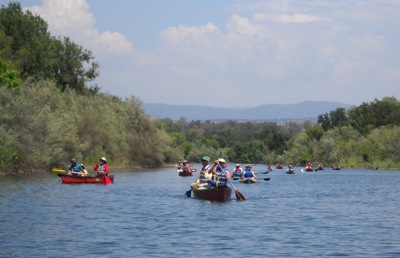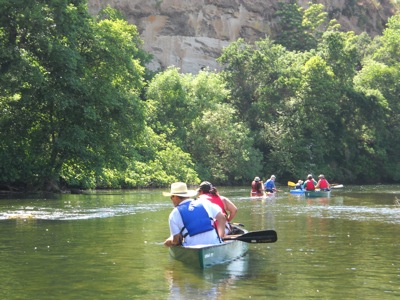Here are some more journal entries from participants in the Paddle to the Sea project, to raise awareness of river and water supply issues. Two paddlers have pledged to go all the way, from the Sierra to San Francisco Bay. At this point, they’ve descended from the high country and are preparing to traverse California’s Great Valley.

Emilio Martinez: Don Pedro Reservoir & Turlock Lake
After the whitewater thrills of the upper Tuolumne, Don Pedro Reservoir was exciting in the same way that a putting green is exciting: smooth and well-groomed, and so accommodating to the well-mannered sportsman. With the whine of the fishing engine accompanying a distinct lack of visual variety in the blond hills, we boated for two hours towards the Dam, then hiked Bonds Flat Road, then J59 for 2 more hours in the near hundred degree heat, examining road kill for diversion. Besides the houseboats and odd floating trash, there was not a whole lot to feed the river-bound soul.
So it was with a complete sense that all the excitement that the River Tuolumne had to offer had been expended during the upper portion that I stepped awkwardly into my canoe on the 27th of May. I had already complacently decided that the River was something of a “has been” and would be nothing now but a gentle, rolling presence.
What a complete and arrogant assumption of what the River is, without any knowledge of the true meaning of that word as Nature herself uses it.
The River, in short, thrashed both my thesis–and companion Tim and I like the inconsequential beings that we are before the River’s sublime power and majesty: it slapped us upside the head with willow branches drenched in chilling waters, banged our thighs and knees with the fiberglass canoe we haughtily thought we’d master it with: instead, it made us respect it and fear it: precisely because we are mere visitors to its emerald green kingdom, our canoes so much jetsam and flotsam in its consciousness: in short, the Tuolumne did everything it needed to do to show us how we must not underestimate Nature, but rather, protect one’s reverence and humility before it so that one can live and be nurtured by it.
Long live the River!

Owen Segerstrom: Don Pedro Reservoir
Today’s crossing of Don Pedro was an instructive microcosm of the damage that dams cause. While the former Tuolumne River Canyon rests under hundreds of feet of water, the remaining habitat is a virtual biological desert. Turkey vultures, mallards, and hatchery-raised fish are a far cry from the wildlife of an intact river system. What was once a salmon-bearing, thriving ecosystem sequestering untold millions of metric tons of carbon is now a layer of anaerobic matter at the bottom of the reservoir, the decomposition of which releases methane (a greenhouse gas that is orders of magnitude more potent that carbon dioxide) into the atmosphere. [Editor’s note: The figure most quoted by scientists is that methane is about 20 times more potent than CO2 as a greenhouse gas. In California, however, livestock and leakage from oil & gas operations are much bigger emitters of methane than natural decomposition from lakebeds].
Upon arrival at the dam, Emilio, Mason (a friend of mine from Kentucky who accompanied us) and I were presented with an interesting conundrum. Despite indications to the contrary from National Geographic’s mapping database, there is no trail from the dam to the Old La Grange bridge. After consulting a local ranger, we determined that the only way to walk this leg of our journey was on the side of Bonds Flat road and eventually J59 (approximately 7 miles). The partially decomposed remains of a fox, whose life was ostensibly claimed by a motorist on the highway, were yet another sobering reminder of the human-caused chasm between a Mt. Lyell-to-the-Pacific river system and the Tuolumne’s current state. We maintained morale by nicknaming this stretch of our sojourn the “great asphalt eddy of the T,” but the experience was nonetheless jarring.
After the experience at Don Pedro, the first section of the Lower Tuolumne was quite literally a breath of fresh air. Heritage oaks, the call of an osprey from its nest along the river bank, and the water’s peaceful meander were a feast for the senses. The integration of community advocacy groups throughout the valley is a hopeful sign for the future of freshwater consciousness, and the results of their efforts are evident.
Though anadromous fish passage beyond the Old La Grange Dam is still impossible, the efforts to address disastrous impacts on salmon populations (an unparalleled gauge of the health of a river ecosystem) between this impasse and the ocean are inspiring. Salmon have been described as the conscience of a watershed, as they represent the lone upstream vector for ocean nutrients that have historically fertilized inland ecosystems. The conscientious cooperation of central valley communities along the Tuolumne represents the utterly necessary prevention of local extinction of Chinook salmon.
[Editor’s Note: Here’s the latest biological opinion on California’s Chinook salmon and how it stands to affect water supplies.]
Turlock Lake to Waterford Park
Today’s paddle began with a conversation about the history of California river advocacy. As our group went through individual introductions, many of the participants recalled the (ultimately unsuccessful) efforts to prevent the damming of the Stanislaus River in the late 1970’s, including Mark DuBois chaining himself to a riverside boulder in protest. While the beauty and avian abundance of yesterday’s journey punctuated the beginning of our day, reminders of the need to rekindle Mark’s passion quickly confronted us. The soundscape for our lunch break was provided by an industrial gravel pit, the footprint of which has massively diverted the river channel. As one volunteer pointed out, the beautiful hyacinth blooming in the pond adjacent to the pit were nonetheless a dubious indicator of the river’s ecological health. The day culminated in a rousing gathering of Waterford’s riverfront restoration community at the local park, A group of children enjoying a game based on answering questions about salmon presented hope that somewhere there is a young person who will carry Mark’s torch in defense of the Tuolumne’s continuity.
Our posts are running a bit behind the paddlers’ progress. In real time, they are set to cross San Francisco Bay today and conclude their journey tomorrow, with a celebration at Aquatic Park in San Francisco.
